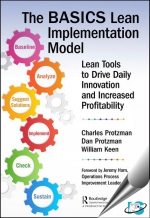Tab Article
The Lean Practitioner Tools outlines a true learning path for anyone seeking to understand essential Lean principles and tools. It includes a plethora of examples and stories drawn from the authors experiences and lessons learned through implementation.
The author breaks down Lean concepts to their simplest terms to make everything as clear as possible for Lean practitioners. The book takes readers on a journey that begins with an overview of Lean principles and culminates with readers developing professionally through the practice of self-reliance. It outlines an integrated, structured approach identified by the acronym BASICS (baseline, analyze, suggest solutions, implement, check and sustain), which is combined with a proven business strategy to help ensure a successful and sustainable transformation of any organization. The book also discusses Lean tools such as standard work, visual management, kanbans, mistake proofing, planning and scheduling, sequencing activities and load balancing.


